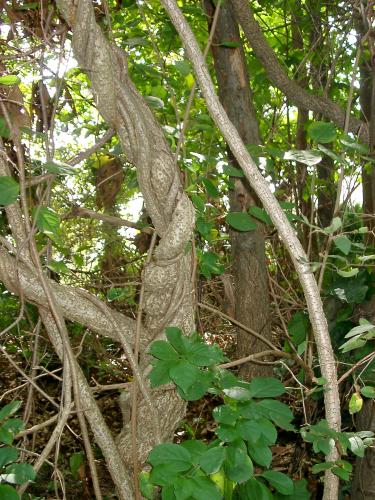Oriental bittersweet: An aggressive, invasive plant
A beautiful plant along the roadways in late fall, Oriental bittersweet is a threat to native environments by aggressively choking out other woody plants. Collecting can cause spreading.

Someone should produce a horror flick about how Oriental bittersweet (Celastrus orbiculatus) can single-handedly strangle neighboring mature trees if left to its own devices. This woody vine grows rapidly and has a twining nature that clings to anything going up or down. It can easily climb trees up to 90 feet tall. As the plant grows in diameter, it literally chokes or girdles other plants that it is clinging to. Its rate of spread is a bit like a Jack-in-the-bean-stalk fairy tale and it has been observed covering half-acre wood lots in just seven to 10 years. Between the girdling growth habit and sheer weight, whole canopies of a forest can tumble down during the growing season or an ice storm.
Bitter beauty – bittersweet aptly named
Why all the interest right now? At the close of the season when leaves of other trees have descended to their winter bliss, the intensely colored, conspicuous fruits of Oriental bittersweet climbing fences, trees and telephone poles are highly noticeable. Conjuring up comforting scenes of autumn, this red and gold fruit entices the fall decorator to jump out of the car to clip stems and transport them home. Unknowingly, the decorator has just become an “accessory” to the spread of this prolific and invasive plant.
According to Michigan State University Extension, Oriental bittersweet is a relative to our native bittersweet (Celastrus scandens) and has several closely linked characteristics. The fruit of both species is made up of an orange outer skin that opens to reveal a red, fleshy fruit. The native bittersweet produces the fruits at the ends of the vines while Oriental type produces its fruit all along the stem.

Vigorous, twining growth can easily girdle large trees.
The seeds of Oriental bittersweet will germinate in open grass lands or shady woodlands and are an attractive food to birds late in the season. Literature suggests that seed can remain in the birds’ stomach for weeks, allowing it to be “deposited” long distances away from the original infestation.
Oriental bittersweet commonly occurs along the edge of a road where infestations are easily noticed and harvested by “unsuspecting” collectors. Broadly-oval, glossy leaves bear fine teeth and can be 2 to 5 inches long. Insignificant, light-colored flowers appear in May and June on separate male and female plants, like holly. This can be seen this time of year when some plants are clearly without fruit, growing right next to one that has fruit.

Bittersweet plants are easy to spot this time of year. Brightly colored fruits entangle other woody plants along the roadside.
Oriental bittersweet also reproduces readily by spreading underground roots, making it very difficult to eradicate by digging. One might notice a “clump” of this vine in their front yard that seems somewhat benign at first. The clump spreads, eventually reaching a tree or fence where it can climb. Don’t be fooled if the plant never bears fruit – you just have the “male” plant.
While environmentally savvy gardeners seek to reduce pesticide use, this is one plant it would be best not to try to control solely by manual methods. In combination with chemical controls, methods such as cutting or hand digging can be effective for established populations over time. Herbicides can be applied to freshly cut stems or through other techniques. Refer to a Michigan DNR fact sheet for best control practices of Oriental bittersweet.
Remember to read and follow all pesticide label directions. When manually removing established populations, it is imperative to continue to observe the patch for newly germinating seedlings or sprouts from underground plant parts.
Additional information:
- Midwest Invasive Species Information Network (MISIN)
- Oriental bittersweet fact sheet from MISIN
- MISIN Resources from MSU Extension
- Report invasive species quickly and easily and look good doing it!
- Midwest Invasive Plant Network (MIPN)
For more information on a wide variety of smart gardening topics, or to find out about smart gardening classes and events, visit the Gardening in Michigan website.



 Print
Print Email
Email



